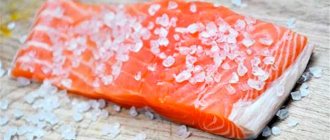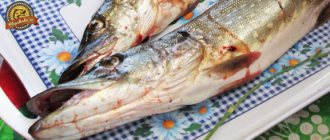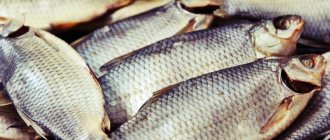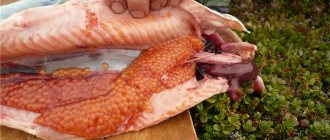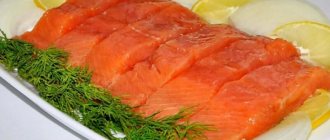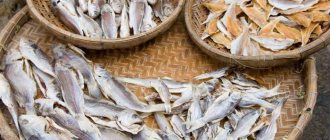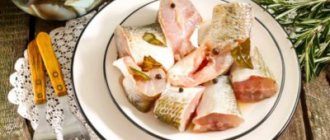How to pickle chinook salmon at home
The simplest recipe for preparing Chinook salmon is dry-salting the fillet. Lightly salted chinook salmon can be added to salads, snacks, even simple sandwiches will be incredibly tasty.
I suggest trying an unusual recipe with the addition of vodka (you can use rum or brandy), which will make the meat more tender.
You will need:
- 1 kg. – fish fillet
- 2 tbsp. spoons - coarse salt
- 1 tbsp. spoon (a little less is possible) – granulated sugar
- 60 ml. – vodka
- Spices (dry dill, fennel seeds, bay leaves, peppercorns) - to taste
How to cook:
1. Rinse the fish fillet well with cold water, dry with a paper towel, rub with vodka, and leave to marinate for 15 minutes.
2. In a separate bowl, mix salt and granulated sugar and rub well with the resulting mixture.
3. Place in a large glass (enamel) bowl, skin side down, add any spices to your taste, cover the fish with a lid, plate or cling film.
4. Place in the refrigerator for 48 hours, now you can taste it.
Calorie content per 100 g. – 148 kcal
Bon appetit!
Recipe for “Lightly salted Chinook salmon at home”
• First of all, we kick out the cat, who was freaking out while I was jumping with the camera, and decided that it was covered especially for him (animal lovers, please don’t worry, he will get it too, but later).
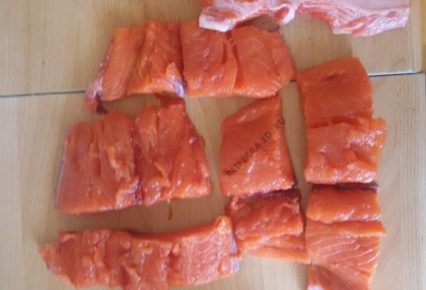
• Cut the fillet into equal pieces, layer thickness, 10-15 centimeters wide. • We make a mixture for salting: • Mix salt with sugar 3 to 2 (Chinook salmon “loves sugar”, I will soon publish a recipe for “royal salting”, which is dry and most suitable for this type of salmon). Add seasoning for salting fish, I usually take two different types. One just for fish, the second specifically for red fish. If there are no seasonings, it will be enough: salt, sugar, pepper and dried herbs (parsley, dill).
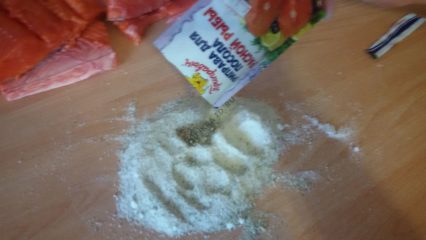
• Knead the mixture so that there are no lumps of salt and mix thoroughly. As stupid as it may sound, careless cooks often end up with fish that is sweet on one side and over-peppered on the other precisely because of such a trifle.
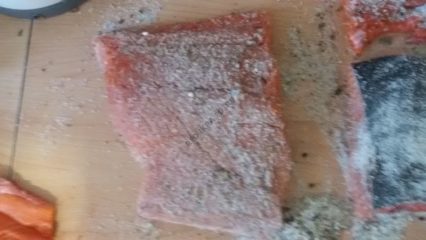
• Sprinkle the mixture on both sides of our fillets. You shouldn’t skimp on salt, but it’s also not advisable to drown fish in it. The phrase “the fish will take as much as it needs” is definitely not suitable for this type of salting, especially for tender Chinook salmon. In addition, salt is needed to absorb excess moisture, and not to impart a special taste; chinook salmon is fine without it.
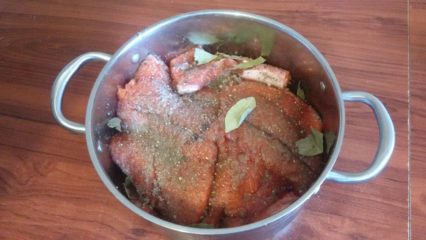
• Take a pan (bucket, barrel, etc.), if you salt the fish so that it comes out lightly salted, you don’t need to fill the bottom with salt. We lay out our fillet pieces in layers, throwing 2-3 bay leaves between the layers. It is important to remember that the layers are laid out with the scales facing down; if the meat touches, it will stick together.
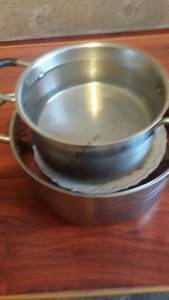
• Press with a press. It would be better if it pressed not only on the center, but occupied most of the area of our pan. But at the same time, it was not close to the walls, otherwise during the salting process, the released juice would go beyond the edges. • Place the dough in the refrigerator for 40 hours. Under pressure in the refrigerator, the fillet is compressed, which prevents the formation of air pockets in the meat where bacteria can grow. • I usually salt chinook salmon in the evening, in the morning it’s ready within 24 hours, but according to GOST, salting needs to take 40 hours, no less. I would like to note that the salting time is not universal and other varieties of salmon take longer to salt. The fact is that Chinook salmon meat is very tender and, as I already said, this is a noble salmon, so 1.5-2 days is the optimal time for it to be fully prepared and acquire a lightly salted taste. If you want to pickle coho salmon and need a recipe, here is the link. • Take the pan out of the refrigerator, try it, enjoy. Then everything depends on your needs. You can cut the fillet into thin layers for sandwiches or rolls, you can chop it into cubes for salad or tartare, and if in your case the delicacy needs to be preserved for a long time, chinook salmon should be frozen.
How to cook chinook salmon in a frying pan
The frying process will not take you much time - about 15 minutes will be enough, and you will have a delicious dinner ready. And it's best to cook on a grill pan.
You will need:
- 3-4 pcs. – steak or pieces of Chinook salmon fillet
- Olive oil – for frying
- Salt, spices, pepper - to taste
- Half a fresh lemon
- 1 piece each – large red tomato and sweet bell pepper
- Fresh lettuce leaves - for a beautiful presentation of the dish
How to cook:
1. Wash the fish, dry it, sprinkle with salt and spices, fry in a frying pan in vegetable oil for about 5-7 minutes on each side.
2. While the fish is frying, cut the peeled pepper into rings and tomatoes into slices.
3. Wash the lettuce leaves, dry them, and place them beautifully on a serving plate.
4. Place the finished fish on lettuce leaves and sprinkle with lemon juice.
5. Fry the vegetables in the same frying pan and add to the fish. Everything is ready, you can set the table.
Note to the hostess! In the same way, you can fry this fish on the grill. To make the fish more juicy, each piece should be wrapped in foil.
Calorie content per 100 g. – 231 kcal
Bon appetit!
How to properly and quickly salt salmon at home?
It is very easy to prepare delicious red fish at home. The recipe is not complicated and does not require special skills or knowledge. And you can try salted salmon prepared with your own hands in just 24 hours. The dry salting method is a proven method that does not require a lot of fuss and the use of special utensils. In fact, fish is salted in its own juice.
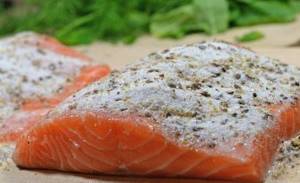
How to cut and select fish?
- First, the purchased carcass must be thoroughly rinsed under running water and dried well with a paper towel;
- Using a sharp knife, you need to separate the head and fins from the body and remove the resulting parts for cooking the fish soup;
- to properly separate the fillet, the tip of the knife is placed at the ridge, and the fish is carefully cut through, but you need to leave 5 centimeters to the end of the tail;
- the remaining salmon is turned over to the other side and the process is repeated;
- then the bones are removed from the resulting pieces;
- the fish is cut into pieces of the required size.
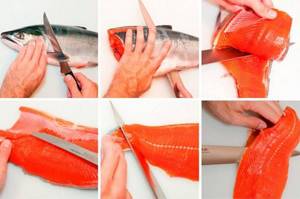
You can also use steaks for salting, then the cutting process will be significantly simplified, but the cooking time will increase. Choosing the right weight of salmon is also very important. A carcass weighing from 2 to 3 kilograms is considered optimal. A smaller fish will have many small bones, but the meat of a larger fish will be tough and very fatty.
For the presented cooking method you will need 500 grams of fresh salmon, 2 tablespoons of coarse salt, 1 teaspoon of sugar. The amount of ingredients for pickling can be increased or decreased simply by maintaining the proportions. It is not recommended to salt salmon fillets with iodized or “extra” class salt.
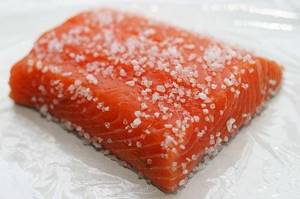
Dry salted salmon
- the prepared pieces of salmon need to be thoroughly dried and the required amount of additional ingredients must be measured;
- mix salt and sugar and sprinkle the prepared carcass or pieces well with the prepared mixture;
- It is worth noting that the white crust should be uniform, the gaps should be removed, otherwise the salting will occur unevenly and the taste will be spoiled;
- Salting salmon should be done in a tightly closed container using pressure, but this is not a prerequisite;
- salt-crusted fish must be stored in the refrigerator and the liquid that will form during the cooking process must be drained;
- If you do not drain the liquid from the fish, it will become over-salted and will not be suitable for consumption.
After a day, you can try the salmon; if the taste is good, then the salt crust can be washed off and served. Otherwise, leave the carcass in the salt coat for another 12 hours. If desired, the finished product can be sprinkled with green dill or sprinkled with lemon juice. Delicious and healthy salmon is ready.
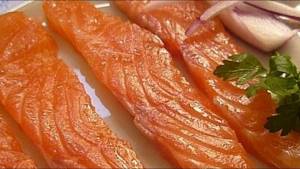
The Frost-Fish company offers only high-quality and proven fish, which can be salted at home without worrying about its freshness.
Return to list
Tender chinook salmon cutlets
The fillet is very easy to separate from the backbone and is well suited for making minced meat for fish cutlets. In this recipe there is no need to add lard; onions are enough for juiciness.
You will need:
- 0.5 kg. – clean fillet without skin and bones
- 2 pcs. – large bulbs
- 3 pcs. – garlic clove
- 1 PC. - chicken egg
- 2 pieces – dry loaf
- 100 ml. – milk (you can take clean water)
- 5-6 tbsp. spoons - breadcrumbs
- Salt, pepper, vegetable oil
How to cook:
1. Soak dry loaf slices in milk.
2. Grind the prepared fillet, peeled onions and cloves of garlic through a meat grinder.
3. Add bread crumb, egg, salt, spices to the resulting minced meat, mix everything, form beautiful cutlets (about 8-9 pieces).
4. Roll the finished semi-finished product in breadcrumbs and fry in vegetable oil on both sides.
Calorie content per 100 g. – 105 kcal
Note to the hostess! I like to add a small piece (about 30 grams) of grated cheese to fish cutlets.
Bon appetit!
How to salt red fish at home?
There are many types of red fish that have won the attention and love of many gourmets: salmon, trout, sockeye salmon, pink salmon, coho salmon, chum salmon, salmon, chinook salmon, nelma, whitefish - and these are only the most popular varieties. The benefits of red fish are preserved better, of course, in its raw form, but if we talk about processing methods, then it will give the most vitamins, microelements, and fatty acids to the human body when cold smoked or after salting at home.
Salting red fish at home with your own hands will always have undeniable advantages compared to buying salted fish:
- firstly, store-bought fish undoubtedly has a certain amount of preservatives added for its longer storage, so that it does not have time to spoil before someone buys this product; - secondly, the question of price - ready-made salted red fish costs almost twice as much as fresh; - thirdly, you salt the fish yourself to your taste - add as much salt and spices as your own taste tells you, and not as is customary on the production line. Thanks to this, your red fish turns out tender, aromatic, fresh, cooked with soul, and therefore many times healthier and tastier.
Therefore, every gourmet red fish lover needs to know a couple of recipes to suit his taste in order to please himself and his household from time to time. We will try to cover every aspect of this process, which is not labor-intensive, but requires certain knowledge.
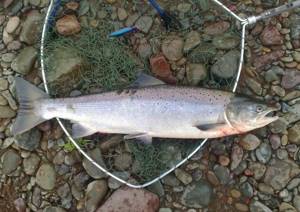
First step - choose red fish
In the process of salting red fish at home, a lot depends on the red fish itself, which you choose in a store or at the market. It is best to buy an uncut whole carcass; it can be chilled, which would be ideal in our case, or frozen. The softest and most tender meat is considered to be salmon, trout and sockeye salmon. Pink salmon and chum salmon are not such fatty fish varieties, so when salting, sunflower or olive oil is added to them for juiciness. From an aesthetic point of view, salmon and trout will look the most impressive on the table due to the fact that these are the largest varieties of red fish of all.
The second step is to prepare the workplace
Now you need to equip a comfortable workplace. You will need a kitchen carving knife, a container for salting fish, a weight (something heavy to press the fish in the container), a mixture of salt and spices, and culinary scissors. It is best to choose a container for salting made of glass; in extreme cases, enamel or plastic food containers are suitable - consider its size so that all the fish that you will salt will fit. As a pressure, you can take a three-liter glass jar of water, a plastic bottle also filled with water, or something similar. You can do without oppression - it promotes better penetration of salt and spices into the fish meat. If the purchased red fish is frozen, leave it to defrost at room temperature - under no circumstances put it in the microwave, under water or speed up the process in any other way, everything should happen naturally.
Third step - cut the fish
First, cut off the head of the fish with a carving knife, and all the fins with culinary scissors. Then we cut the belly and take out the fish entrails. If you find caviar in the abdomen, carefully remove it without damaging it, peel it off the thin film and place it in a small container with salted warm water (two tablespoons of salt per half liter of water), leave it there for 10 minutes. If there is milk in the belly, feel free to salt it along with the main carcass. To free the carcass from the bones, you need to cut it in half along the spine and remove the bones by hand. The remaining unused fins, head, and tail can be frozen and later used to cook aromatic and rich fish soup.
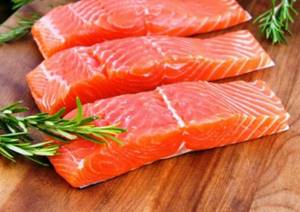
Fourth step - prepare the mixture for salting fish
The mixture for salting red fish is always prepared from two components - salt and sugar. If you decide to use any spices, it can be any fresh or dried herbs and herbs, bay leaf, chopped coriander, allspice, mustard - they are added last. For 1 kilogram of fish meat, take 3 tablespoons of the mixture (you can vary the proportion to your taste). It is best to take coarse salt, without additives - it will promote the release of fish juice, making the taste of already salted fish more natural and natural. How to use oppression - you coat the fish with the mixture you have prepared, then place it in a bowl, place a plate or flat lid on top so that it directly touches the fish, and press everything on top with oppression. It will speed up the salting process and help the fish release more of its own juices.
Fifth step - recipes for salting red fish
1. Red fish, salted under pressure
1 kilogram of red fish 2 tablespoons salt 1 tablespoon sugar
Mix salt and granulated sugar. Rub the fish carcass with this mixture, carefully place it in a bowl, and press down with pressure. Leave at room temperature for 2-3 hours, then remove the fish from the dish, remove excess salt and sugar mixture from it and put it in the refrigerator for one day.
2. Dry salting of red fish
1 kilogram of red fish 2 tablespoons of salt 2 tablespoons of sugar 1 teaspoon of coriander seeds 1 teaspoon of allspice corns bay leaf (4-5 leaves) a piece of cotton cloth according to the size of the fish paper towels
Rub the fish carcass with a mixture of salt and sugar, place bay leaves on the inner barrel, and sprinkle the carcass with spices. After this, swaddle the fish tightly in cotton cloth, skin to linen, then wrap in paper towels. Place in a bowl and refrigerate for 2-3 days. Every morning and evening you need to change the paper towels for new ones and turn the fish on one side or the other.
3. Red fish in soy sauce
1 kilogram of red fish 4 tablespoons salt 4 tablespoons soy sauce 2 tablespoons sugar juice of one lemon
Mix salt and sugar, add soy sauce and lemon juice. Thoroughly rub the fish carcass with this mixture, place in a bowl, cover with cling film and refrigerate for a day. If you eat fish for a long time, for better preservation you can put it in a glass jar and fill it with vegetable oil. When using this recipe for salting red fish, remember that any soy sauce is a product of processing genetically modified soybeans, which does not provide any benefit to the body.
4. Red fish with dill
1 kilogram of red fish 2 tablespoons salt 2 tablespoons sugar large bunch (about 200 grams) of fresh dill
Wash and dry the dill on a towel in advance. Mix salt and sugar and rub the fish with it. Take a third of a bunch of dill and cover the bottom of a pickling bowl with it, put half of the fish carcass on top, skin down, and cover it with the second third of sprigs of greenery. The next layer will be the second half of the fish, laid with the skin up, and finally the last layer - the remaining third of the dill sprigs. Cover everything with a plate and leave under pressure for 7-8 hours at room temperature, then put the bowl of fish in the refrigerator - after two days the fish will be ready.
5. Red fish in marinade (pink salmon, chum salmon)
1 kilogram of red fish 2 tablespoons of salt 1 teaspoon of sugar 100 ml of vegetable oil onion, cut into half rings bay leaf (5-6 leaves) black peppercorns
This recipe is especially good for low-fat varieties, such as pink salmon and chum salmon: the fish turns out lightly salted, tender, juicy and soft, very appetizing. Mix butter with salt and sugar, add black pepper, bay and onion. Cut the red fish into pieces 3-4 cm thick (to make it easier to cut, the carcass can be frozen a little), mix well in a large bowl with brine and place in a glass jar. After 8-10 hours in the refrigerator, the fish is ready. Let's make a reservation about vegetable oil: if you care about your health, it is better to use unrefined sunflower or olive oil, because it retains vitamins and other beneficial substances, does not contain artificial chemical additives, and adds a special flavor to any dish.
We looked at the most delicious basic recipes for salting red fish with your own hands at home.
Finally, some useful tips for aesthetes. There is no point in rinsing fish under water after salting, it will lose half of its taste, and it does not need chlorine and other chemicals contained in city tap water. The carcass can be cleaned of spices and brine using a soft brush and napkins or paper towels, blotting the fish with them. On a holiday table, fish will look beautiful and aesthetically pleasing if you cut it into pieces, place it on a large dish, place lemon cut into slices next to it, and sprinkle fresh finely chopped herbs (dill, parsley, cilantro, celery) on top.
Bon appetit and more healthy homemade food on your table!
How to deliciously cook chinook salmon in the oven with potatoes
This fish tastes best with potatoes, and the potatoes absorb all the fat and also turn out very tasty.
You can choose the quantity and assortment of vegetables to your taste; you can also add, for example, tomatoes, bell peppers, zucchini, eggplant.
You will need:
- 1 kg. - fish
- 7-8 pcs. – small potatoes
- 2 pcs. – medium-sized carrots and onions
- Salt, spices, bay leaf, vegetable oil - to taste
- Half a lemon
- 100 gr. – yogurt or sour cream
- A small bunch of fresh dill
How to cook:
1. Potatoes, wash, peel, cut into slices, boil for about 5 minutes.
2. Cut the peeled onion into half rings, grate the carrots on a coarse grater.
3. Cut the fish into portions, salt and pepper, sprinkle lightly with lemon juice.
4. Grease a baking tray or baking dish with vegetable oil, lay out the potatoes in an even layer, distribute the onions and carrots on top, salt and pepper everything to taste.
5. Next, lay out the fish pieces.
6. Mix sour cream or yogurt with chopped dill, add spices, pour our chinook salmon on top.
7. Place in the oven for 50 minutes at t=180 C.
Note to the hostess! This dish can be prepared in portions if each piece of fish and vegetables is wrapped in a boat made of foil.
Calorie content per 100 g. – 98 kcal
Bon appetit!
Chinook salmon cutting
Any cook who has tried to salt fish at least once will confirm that the most difficult thing is preparing the fillet. I would like to point out right away that it is very important to have a sharp knife, otherwise it will be a disaster and you will suffer. It is also convenient to use scissors when cutting. I make 2 preparations from whole chinook salmon, one for soup, the other for salting. • The head and tail are cut off.
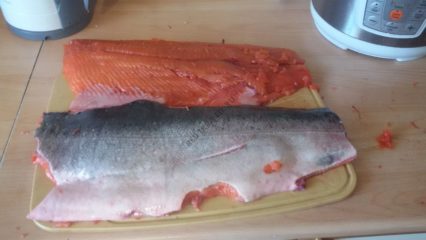
• The fins are cut with scissors; I cut them with a piece of meat 3-5 cm (in the photo), because These are the fatty parts of fish, which definitely won’t hurt your ear. • The abdomen is cut open and all the insides are removed. • Important, pay attention to the strip of blood along the entire spine; it must be removed, otherwise poisoning may occur. • Next comes the most difficult part: an incision is made along the ridge and the spine is removed along with the ribs. If the chinook salmon has already been lying down and the meat is quite soft, then everything is more difficult, it is better to cut it into 2 layers, on the first layer the spine with all the ribs should be easily stretched out with pliers, from the second layer you will have to remove the bones individually, with pliers or by prying them with a knife (if you are too lazy, you can remove the bones with a long knife, simply cutting them along the inside of the ribs, along with a small layer of meat, in the photo I did this, because I have an abundance of Chinook salmon).
Salad with lightly salted Chinook salmon
You can select the quantity and range of ingredients to suit your taste.
You will need:
- 1 piece each – small cucumber, celery stalks, avocado
- 5-6 pcs. – cherry tomato
- 100 gr. – lightly salted fish
- Iceberg lettuce, arugula, olives - to taste
- Half a lemon
- Salt, pepper, sesame seeds - to taste
How to cook:
1. Tear the lettuce leaves with your hands.
2. Chop cherry tomatoes, cucumber, celery, avocado, fish fillet.
3. Mix all prepared products in a large bowl, season with oil, sprinkle with lemon juice, add salt, pepper, stir, add olives, sprinkle with sesame seeds.
Bon appetit!

